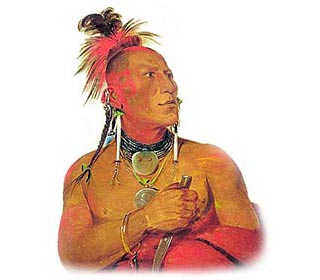The tribes that were relocated to Oklahoma included the Arapaho, Cayuga, Cherokee, Cheyenne, Chickasaw, Choctaw, Creek, Delaware, Fox, Iowa, Kaw (see above picture), Kickapoo, Miami, Otoe, Modoc, Ottawa, Pawnee, Ponca, Potawatomi, Quapaw, Sauk, Seneca, Shawnee, Wyandotte and Yuchi. Oklahoma - Indian Territory
Indian Territory was a vast area of U.S. federal territory on the Great Plains reserved for Indians from the 1830s to the 1880s. In the 1870's the deliberate great slaughter of the northern bison herds began designed to prevent the Native Indians continuing the Great Plains lifestyle. Indian Territory eventually became the states of Kansas, Nebraska, and Oklahoma. By 1907, when Oklahoma was admitted as a state, Indian Territory ceased to exist. Fast Facts about the History of Oklahoma Indians
The climate, land, history, environment and natural resources that were available to the indigenous Indian tribes in Oklahoma resulted in the adoption of the Southeast culture and some adopted the Great Plains Indians culture. - Name of State: Oklahoma
- Meaning of State name: Two Choctaw words were combined to mean red person - "ukla" meaning person and "huma" meaning red to form the word
- Geography, Environment and Characteristics of the State of Oklahoma: High plains, hills, small mountains and River Basin
- Culture adopted by Oklahoma Indians: Southeast Cultural Group and some adopted the Great Plains culture
- Languages: Muskogean
- Way of Life (Lifestyle): Hunter gatherers and hunter farmers
- Types of housing, homes or shelters: Asi Wattle and Daub houses
History Timeline of the Oklahoma Indians
The history and the way of life of Oklahoma Indians was profoundly affected by newcomers to the area. The indigenous people had occupied the land thousands of years before the first European explorers arrived. The Europeans brought with them new ideas, customs, religions, weapons, transport (the horse and the wheel), livestock (cattle and sheep) and disease which profoundly affected the history of the Native Indians. For a comprehensive History timeline regarding the early settlers and colonists refer to the Colonial America Time Period. The history of the State and of its Native American Indians is detailed in a simple History Timeline. This Oklahoma Indian History Timeline provides a list detailing dates of conflicts, wars and battles involving Oklahoma Indians and their history. We have also detailed major events in US history which impacted the history of the Oklahoma Indians. Indian Wars - Indian Territory
Indian Territory was a vast area of U.S. federal territory on the Great Plains reserved for Indians from the 1830s to the 1880s. Indian Territory eventually became the states of Kansas, Nebraska, and Oklahoma. By 1907, when Oklahoma was admitted as a state, Indian Territory ceased to exist. During the 1700's many different tribes from the great Indian Nations were forced to move from their homelands and were granted land in Oklahoma. - 10,000 B.C.: Paleo-Indian Era (Stone Age culture) the earliest human inhabitants of America who lived in caves and were Nomadic hunters of large game including the Great Mammoth and giant bison.
- 1000 AD: Woodland period with permanent houses and farming
- 1540: Hernando de Soto (1500-1542) explores Oklahoma in search of gold
- 1541: Francisco Vasquez de Coronado (1510-1554) explores Oklahoma
- 1775: 1775 - 1783 - The American Revolution.
- 1776: July 4, 1776 - United States Declaration of Independence
- 1803: The United States bought the Louisiana Territory from France for 15 million dollars for the land
- 1812: 1812 - 1815: The War of 1812 between U.S. and Great Britain, ended in a stalemate but confirmed America's Independence
- 1800: 1817 Fort Smith, a military post, was established at the mouth of the Poteau River, on the eastern border of Oklahoma
- 1830: Indian Removal Act
- 1832: Department of Indian Affairs established
- 1832: 1832-1839: Removal of the Cherokee Indians, one of the "Five Civilized Tribes", to Indian Territory on the Trail of Tears
- 1834: The First Dragoon Expedition of 1834 (also called the Dodge-Leavenworth Expedition or Pawnee expedition) was the first official contact between the US government and the Plains Indians including the Pawnee and Comanche
- 1836: 1836 - 1837 - The Second Creek War (Seminole War)
- 1858: 1858-1859 - Wichita expedition in Indian Territory
- 1860: Kiowa and Comanche expedition, Indian Territory. To remove the Kiowa and Comanche from the area of the Arkansas River.
- 1861: 1861 - 1865: The American Civil War.
- 1862: U.S. Congress passes Homestead Act opening the Great Plains to settlers
- 1863: 1863-1869 War against the Cheyenne, Arapaho, Kiowa and Comanche Indians in Kansas, Nebraska (Territory), Colorado (Territory) and Oklahoma Indian Territory
- 1865: The surrender of Robert E. Lee on April 9 1865 signalled the end of the Confederacy
- 1874: 1874-1875 - Campaign against Kiowa, Cheyenne and Comanche Indians in Indian Territory
- 1877: A group of 972 Cheyenne were escorted to Indian Territory in Oklahoma. The government intended to re-unite both the Northern and Southern Cheyenne into one nation.
- 1887: Dawes General Allotment Act passed by Congress leads to the break up of the large Indian Reservations and the sale of Indian lands to white settlers
- 1909: Crazy Snake Rebellion between the Creek Indians and white settlers in Oklahoma
- 1969: All Indians declared citizens of U.S.
- 1979: American Indian Religious Freedom Act was passed
History of Oklahoma Indians - Destruction and Decline
The history of the European invasion brought epidemic diseases such as tuberculosis, cholera, influenza, measles and smallpox. The Native Indians of Oklahoma had not developed immunities against these diseases resulting in huge losses in population. Exploitation including the leverage of taxes, enforced labor and enslavement were part of their history, taking their toll on the Oklahoma Indians. |
